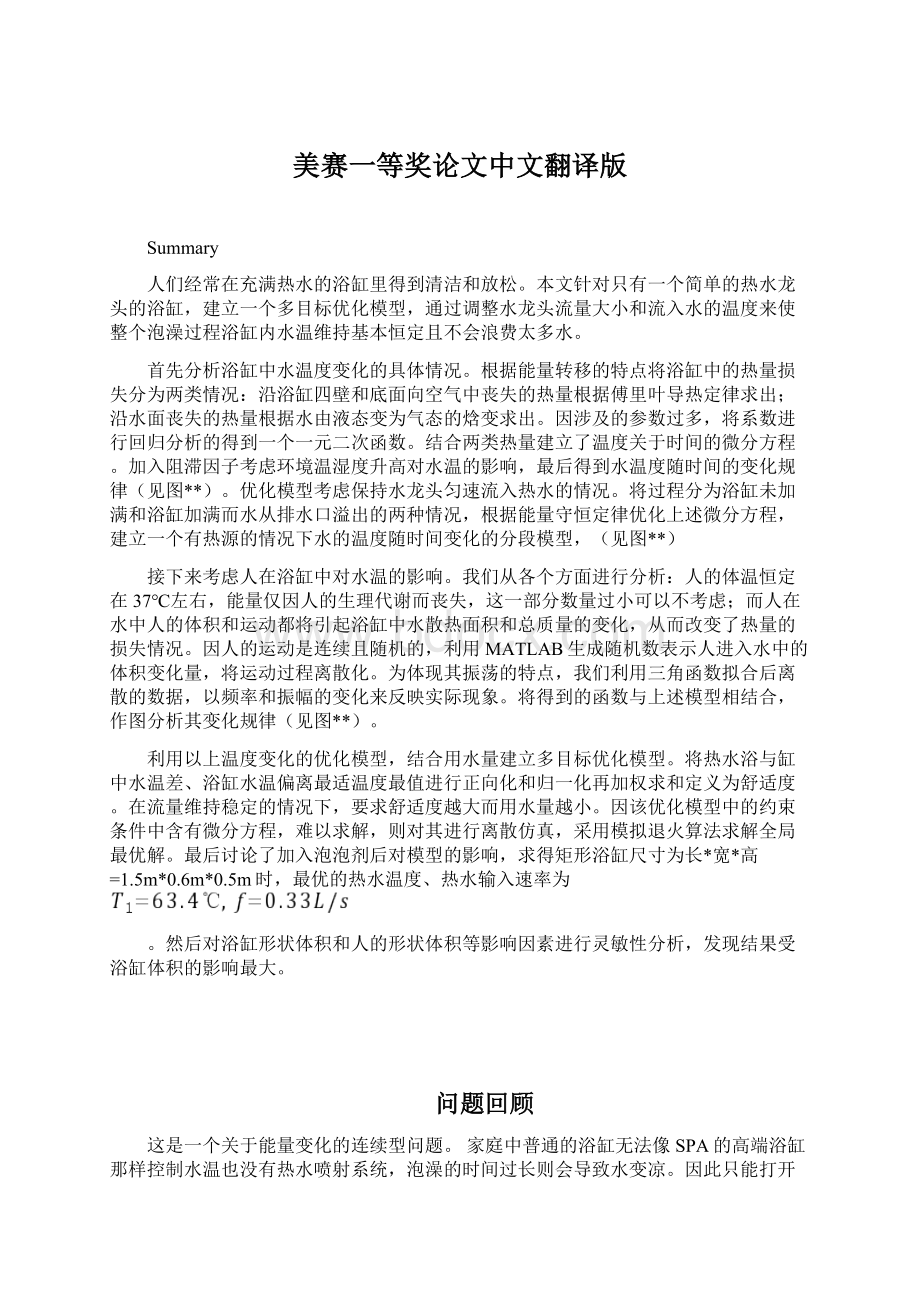美赛一等奖论文中文翻译版.docx
《美赛一等奖论文中文翻译版.docx》由会员分享,可在线阅读,更多相关《美赛一等奖论文中文翻译版.docx(40页珍藏版)》请在冰豆网上搜索。

美赛一等奖论文中文翻译版
Summary
人们经常在充满热水的浴缸里得到清洁和放松。
本文针对只有一个简单的热水龙头的浴缸,建立一个多目标优化模型,通过调整水龙头流量大小和流入水的温度来使整个泡澡过程浴缸内水温维持基本恒定且不会浪费太多水。
首先分析浴缸中水温度变化的具体情况。
根据能量转移的特点将浴缸中的热量损失分为两类情况:
沿浴缸四壁和底面向空气中丧失的热量根据傅里叶导热定律求出;沿水面丧失的热量根据水由液态变为气态的焓变求出。
因涉及的参数过多,将系数进行回归分析的得到一个一元二次函数。
结合两类热量建立了温度关于时间的微分方程。
加入阻滞因子考虑环境温湿度升高对水温的影响,最后得到水温度随时间的变化规律(见图**)。
优化模型考虑保持水龙头匀速流入热水的情况。
将过程分为浴缸未加满和浴缸加满而水从排水口溢出的两种情况,根据能量守恒定律优化上述微分方程,建立一个有热源的情况下水的温度随时间变化的分段模型,(见图**)
接下来考虑人在浴缸中对水温的影响。
我们从各个方面进行分析:
人的体温恒定在37℃左右,能量仅因人的生理代谢而丧失,这一部分数量过小可以不考虑;而人在水中人的体积和运动都将引起浴缸中水散热面积和总质量的变化,从而改变了热量的损失情况。
因人的运动是连续且随机的,利用MATLAB生成随机数表示人进入水中的体积变化量,将运动过程离散化。
为体现其振荡的特点,我们利用三角函数拟合后离散的数据,以频率和振幅的变化来反映实际现象。
将得到的函数与上述模型相结合,作图分析其变化规律(见图**)。
利用以上温度变化的优化模型,结合用水量建立多目标优化模型。
将热水浴与缸中水温差、浴缸水温偏离最适温度最值进行正向化和归一化再加权求和定义为舒适度。
在流量维持稳定的情况下,要求舒适度越大而用水量越小。
因该优化模型中的约束条件中含有微分方程,难以求解,则对其进行离散仿真,采用模拟退火算法求解全局最优解。
最后讨论了加入泡泡剂后对模型的影响,求得矩形浴缸尺寸为长*宽*高=1.5m*0.6m*0.5m时,最优的热水温度、热水输入速率为
。
然后对浴缸形状体积和人的形状体积等影响因素进行灵敏性分析,发现结果受浴缸体积的影响最大。
问题回顾
这是一个关于能量变化的连续型问题。
家庭中普通的浴缸无法像SPA的高端浴缸那样控制水温也没有热水喷射系统,泡澡的时间过长则会导致水变凉。
因此只能打开水龙头让热水源源不断的流进来,但是当水满了之后就打开排水口使得水从排水口流出,按照此种办法使得浴缸中的水保持相对恒定的温度。
Thisisacontinuousproblemaboutenergychanges.HouseholdsintheordinarybathtubcannotbeliketheSPA'shigh-endbathtubthatcontrolwatertemperature,thereisnohotwaterinjectionsystem,bathtoolongwillcausethewatercools.Thereforeonlyopenthefaucettoletwaterflowinasteadystream,butwhenthetubreachesitscapacity,excesswaterescapesthroughanoverflowdrain,inaccordancewithsuchanapproachmakesthewaterinthebathtubtomaintainarelativelyconstanttemperature.
我们知道水的温度是随着时间的变化而变化的,但是当加入热水后,浴缸中的水温将会发生变化,他不可以看作是一个恒温物体,因此我们需要建立一个浴缸中的水温关于位置和时间的变化而变化的模型,确定一个最佳的策略,决定水龙头入水量的大小和入水量的时间等因素,使得整个浴缸从头到尾的水都能够保持温度,还要不能浪费太多的水。
Weknowthatthewatertemperaturevariesovertime,butwhenaddedtohotwater,bathwatertemperaturewillchange,itcannotbeseenasaconstantobject,soweshoulddevelopamodelofthetemperatureofthebathtubwaterinspaceandtimetodeterminethebeststrategythepersoninthebathtubcanadopttokeepthetemperatureeventhroughoutthebathtubandascloseaspossibletotheinitialtemperaturewithoutwastingtoomuchwater.
为了详细考虑现实生活中可能发生的情况,我们还要考虑人对温度变化过程的影响。
除了上述涉及到的因素外,浴缸的大小和形状、人的大小和形状、以及人在浴缸中的动作等。
例如可以考虑因人的运动使得水蒸发速率加快,在第一次加水时加入了泡泡剂来帮助清洁的等因素对模型的影响。
Foradetailedconsiderationofreal-lifesituationsthatmayoccur,wehavetoconsiderthehumanimpactontheprocesstemperaturechanges.Inadditiontofactorsrelatedtotheabove,thesizeandshapeofthetub,humansizeandshape,aswellashumanactioninthetub.Forexample,considertheperson'smovementsothatthewaterevaporationrateacceleratedinthefirstadditionofwaterisaddedtohelpcleanthebubbleagentandotherfactorsonthemodel
Inadditiontotherequiredone-pagesummaryforyourMCMsubmission,yourreportmustincludeaone-pagenon-technicalexplanationforusersofthebathtubthatdescribesyourstrategywhileexplainingwhyitissodifficulttogetanevenlymaintainedtemperaturethroughoutthebathwater.
问题分析:
这个问题是一个连续型优化问题,我们应该从最基础的问题分析起,逐步完善和优化,得到最优解。
最开始我们找到一些关于数据,包括一般情况下室温为25℃,洗澡的最适合的温度为39℃,浴缸取的是市面上发展较好的玻璃钢材料的中空保温的浴缸。
Thisproblemisacontinuousoptimizationproblem,westartfromthemostbasicproblemanalysis,andgraduallyimproveandoptimizetogettheoptimalsolution.Tostart,wecollectedsomedata,includinggeneralroomtemperature25℃,themostsuitabletemperaturebathfor39℃,andthebathtubisFRPmaterial.
首先我们考虑的是影响浴缸中水温度变化的因素。
将浴缸中的热量损失分为两类情况,沿浴缸四壁和底面的热量丧失和沿水面因水的蒸发丧失,两类情况设计的计算方法不同。
对于缸壁和底面丧失的热量,在水温达到恒定后,热量丧失主要是因浴缸上的热量向空气中散发,因此可以确定这一部分散发的热量。
而沿水面蒸发的部分我们不能仅仅考虑热对流引起的热量损失,还应该考虑水由液态变为气态,发生了物态变化所吸收的热量,因此我们需要考虑焓变的因素。
其中涉及到的变量过多,对于一些类似于相对湿度和大气压等值可以假定为定值,而对于一些随时间变化的值,因最终考虑的是温度与时间的关系,我们将各参数整合在一起,以一个关于时间的函数来表示。
最后将得到的二者丧失的能量相加,获得丧失的总能量,结合水的质量和比热容,将能量的损失转换成温度的变化。
限定浴缸尺寸大小,做出温度随时间的变化规律。
同时我们也必须考虑空气的温度随时间的变化,而不是恒定在25℃,对模型优化加入阻滞因子,考虑环境温湿度升高对水温的影响。
First,weconsideredthefactorsaffectingthewaterinthebathtubtemperature.Therearetwoformsofbathtubwaterheatloss,heatconductionalongthewallsandbottomofbathtubandwaterevaporationalongsurfaceofthewater.Fortheheatlossofheatconductionalongthewallsandbottomofbathtub,itismainlyduetotheheatbathonthecirculatedair,sowecandeterminethispartoftheheat.Fortheheatlossofwaterevaporationalongsurfaceofthewater,wenotonlyconsideredtheheatlosscausedbythermalconvection,butalsotheheatlosscausedbywaterphasechange,whichisfromaliquidtoagaseousstate,soweconsidertheenthalpychange.Toobtaintherelationshipbetweentemperatureandtime,wesumtheenergylossofthetwotogethertogetthetotalenergyloss,combinedwiththemassofwaterandthespecificheatcapacity,theenergylossisconvertedintoachangeintemperature,anddrawtemperaturevariationwithtimefigure.Atthesametime,wehavetoconsidertheairtemperaturechangesovertime,ratherthanconstantat25℃,andtheenvironmentaleffectsofelevatedtemperatureandhumidityonthewatertemperature,retardationfactorwasaddedtothemodel,
因洗澡时可以一边洗一边加入热水,此时我们要考虑在有热源引入的情况下水温的变化。
结合实际人泡澡时不可能一开始就将浴缸放满,我们假设已经放了80%的39℃的水,从此时考虑加热水的情况。
因此此时情况要分为浴缸未加满和浴缸加满而水从排水口溢出的情况,利用能量守恒定律可得到热量流入流出的关系,建立微分方程,求解作图分析其变化规律。
Becausethepersonaddsaconstanttrickleofhotwaterfromthefaucettoreheatthebathingwater,weconsiderwatertemperaturechangesinthecaseofhotwaterintroducedin.Inreallife,thebathtubcannotbefilledoutset,weassumethatithasbeenput80%ofthe39℃water,fromthispointconsiderthecaseofaddheatingwater.Therefore,thesetwosituationareconsidered,bathtubisnotfilledupandfilledupandexcesswaterescapesthroughanoverflowdrain,usingtheenergyconservationlawtogivetheheatflowinandoutoftherelationship,theestablishmentofdifferentialequations,solvingandgraphinganalyzethevariation.
接下来需要考虑人在浴缸中对水温的影响。
我们从以下方面进行分析:
对于人的体温,因人的温度恒定在37℃左右,能量仅因人的生理代谢而丧失,这一部分数量过小可以不考虑;而人在水中人的体积和运动都将引起浴缸中水的体积的变化,这样将改变其散热面积,从而改变其热量的丧失。
对于人运动的问题,这是一个连续且随机的变量,我们无法直接将他的影响引入温度方程,于是我们考虑将运动过程离散化,每20s为一个周期,利用MATLAB生成的随机数体现其随机性,结合生活实际将随机数与三角函数结合,考虑频率和振幅的变化来将离散的过程连续化,与以前模型相结合。
规定具体条件作图分析其变化规律。
Next,weneedtoconsidertheimpactofpeopleinthebathtubonwatertemperature.Weanalyzethefollowingaspects:
First,forthehumanbodytemperature,thehumanconstanttemperatureisaround37℃,theenergylosscomefromphysiologicalmetabolism,whichistoosmallandcanbeignored.Second,thevolumeofpeopleandmovementswillcauseachangeinthevolumeofwaterinthebathtub,whichwillchangeitscoolingarea,thusaffectingtheheatloss.Third,forthemotionsmadebythepersoninthebathtub,thisisacontinuousandrandomvariables,wecannotdirectlyintroducetheaffectintotemperatureequation,soweconsiderthepersonmovementsdiscrete,eachforaperiodof20s,usingtherandomnumbergeneratedbyMATLABtoreflectitsrandomness,combiningtheactuallifewithrandomnumbersandtrigonometricfunctions,consideringthechangeinfrequencyandamplitudeofthepersonmotions.Finally,weplotandanalyzethevariation.
为了考虑在浴缸中泡澡的最佳方式,需要建立多目标优化模型。
保持温度的恒定实际上是为了使得人更加舒适,因此我们可以从舒适度的角度上来看温度条件,温度必须恒定在39℃左右,而且最大温度和最小温度不能相差过大。
而用水量方面也必须越小越好,根据实际情况分配权重和确定约束条件,建立一个多目标优化模型。
最后可以用离散仿真的方法将最优解求解出来。
Todeterminethebeststrategy,weneedtoestablishamulti-objectiveoptimizationmodel.Keepingthetemperatureconstantaimstomakepeoplemorecomfortable.Wecanconsiderthetemperatureconditionsintermsofcomfort.Thetemperaturemustbeconstantatabout39℃.Therearenottoomuchdifferencebetweenthemaximumandminimumtemperatures.Thewateralsohavetobeassmallaspossible.Accordingtotheactualsituationandassigningaweighttodeterminetheconstraints,weestablishedamulti-objectiveoptimizationmodel.Finally,weuseadiscretesimulationmethodtogettheoptimalsolution.
后面还有接上一段
用离散仿真的方法将连续问题离散化,利用模拟退火的办法求解最优解。
最后分析各个因素对模型的影响:
泡泡剂影响了水的蒸发速度和面积,而对于浴缸的大小体积、人的大小体积和人的运动等因素进行灵敏性分析,得到其影响程度,根据具体情况可以得到各种情况下的最优解。
模型假设:
这个优化模型考虑到了人的形状、体积以及人在浴缸中的运动,浴缸的形状、体积,是否添加泡泡剂,还有时间和空间等方面的因素,要探求保持浴缸中水的用量一定时,用水量最少的情况。
同时考虑所有的约束条件问题复杂,而且有些问题条件我们可以事先作如下假设:
Theoptimizationmodeltakesintoaccountthefactoroftheshapeandvolumeofthetub,theshape/volume/temperatureofthepersoninthebathtub,andthemotionsmadebythepersoninthebathtub,abubblebathadditive,spaceandtimeandsoon.Tokeepthetemperatureeventhroughoutthebathtubandascloseaspossibletotheinitialtemperaturewithoutwastingtoomuchwater.Ifweconsideralltheconstraints,problemsbecomecomplexanddifficulttosolve,sowemakethefollowingassumptionsinadvance:
●对于空气和水,因温度差异大时对流的速度会特别快,我们事先假设温度是分布均匀的,因此未考虑水的空间分布差异。
●Forairandwater,whenthetemperaturedifferenceislarge,convectionspeedparticularlyfast,soweassumethatthetemperatureisevenlydistributedinadvance,thatis,withoutconsideringthedifferencesinthespatialdistributionofwater.
●我们知道温度达的情况下水蒸发的速度也是非常快的,此处我们需要根据水的蒸发情况考虑能量损失,但是相对于整体来说损失的量是非常小的,可以仅仅忽略掉水质量的损失。
●Thehigherthetemperature,thefasterevaporationofwater,soweneedtoconsidertheenergylossofwaterevaporation.Comparedtotheamountofwaterinthebathtub,thewatermasslosscausedbyevaporationisverysmall,soweignorethelossofwaterquality.
符号定义
Symbol
Meaning
q
单位时间下丧失的热量Heatlossperunitoftime
Q
热量损失总量Totalheatloss
水体表面温度Watersurfacetemperature
热传导散热面积Heattransferarea
蒸发散热面积Evaporationcoolingarea
水面蒸发系数Waterevaporationcoefficient
水蒸气饱和分压力Watervaporsaturationpartialpressure
k
定义的简化参数Definedreducedparameters
C
水的比热容Specificheatcapacityofwater
m
水的质量massofwater
浴缸底面周长Bottomcircumferenceofbathtub
热水流入的流量Flowofhotwater
浴缸底面积Bottomareaofbathtub
流入热水的温度temperatureofhotwaterflowinginto
浴缸高